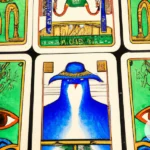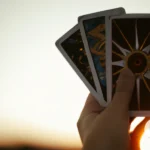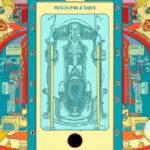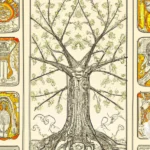As we journey through life, we may find ourselves feeling stuck or repeating negative patterns. These issues may stem from subconscious beliefs and patterns that we are not aware of. However, uncovering these subconscious patterns and beliefs can be challenging. This is where tarot cards come into play. Tarot cards can be used as a tool to tap into the subconscious mind and reveal hidden beliefs and patterns. In this article, we will explore how tarot cards can be used to uncover subconscious patterns and beliefs, interpret tarot card readings, and the benefits of doing so.
What are Subconscious Patterns and Beliefs?
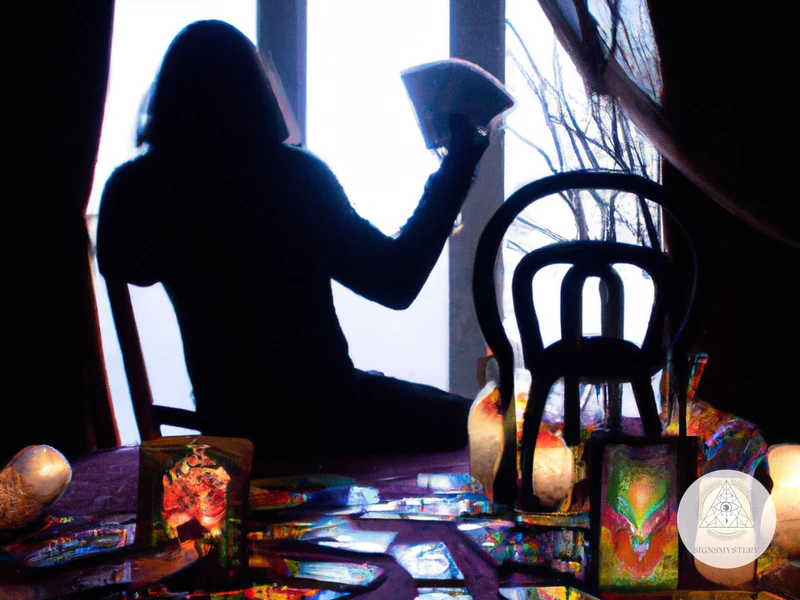
The human mind is complex, and much of its workings happen outside of our conscious awareness. Subconscious patterns and beliefs are one example of this phenomenon. These patterns are ingrained ways of thinking and behaving that we have learned over time and that now operate automatically in our minds. They are often formed in childhood and can persist into adulthood, influencing our thoughts, emotions, and behaviors.
Our mind consists of two parts: the conscious mind and the subconscious mind. The conscious mind is the part that we are aware of and actively use to think and make decisions. It’s the part of the mind that we use to reason, analyze, and plan. On the other hand, the subconscious mind is the part that operates outside of our conscious awareness. It is responsible for processing information at an unconscious level, and it is a reservoir of feelings, thoughts, and memories that influence our behavior without our realizing it.
Subconscious patterns and beliefs can have a significant impact on our lives, shaping the way we think, feel, and act. They influence our self-perception, our relationships with others, and our ability to achieve our goals. Sometimes, these patterns can be positive and helpful, such as healthy habits that we’ve developed over time. But other times, they can be negative and limiting, holding us back from reaching our full potential.
Negative patterns and beliefs can result in self-sabotage, feelings of worthlessness and inadequacy, and can even cause us to repeat the same mistakes over and over again. For instance, we may have negative beliefs about ourselves based on past experiences, such as being rejected or criticized. These beliefs can lead us to avoid certain situations or opportunities, like social events or job interviews, because we believe we are not good enough or that we will be rejected.
Tarot cards can be a useful tool to uncover these subconscious patterns and beliefs and bring them to our conscious awareness. By doing so, we can examine and challenge them, and replace them with more positive and helpful ways of thinking and behaving.
The Conscious and the Subconscious Mind
Our mind is a complex and fascinating thing, with two distinct aspects: the conscious and the subconscious mind. The conscious mind consists of our thoughts, feelings, and perceptions that we are aware of in the present moment. It is the part of our mind that we use to make decisions, solve problems, and engage with the world around us.
On the other hand, the subconscious mind operates beneath the surface of our awareness. It comprises our underlying beliefs, attitudes, and automatic reactions to situations or stimuli. It is the part of our mind that stores our memories, experiences, and emotions that we may not even be aware of. The subconscious mind operates silently and automatically, influencing our daily lives in ways that we may not realize.
These subconscious patterns and beliefs can have a significant impact on our lives, affecting our relationships, behaviors, and decisions. They can either empower us, giving us the confidence and resilience to succeed, or limit us, holding us back from achieving our goals and aspirations.
This is where tarot cards can come in handy. Tarot cards can help us gain insight into our subconscious patterns and beliefs, allowing us to recognize and shift any negative or limiting beliefs that may be hindering our progress. Tarot cards work as a tool for tapping into our subconscious mind and getting in touch with our emotions, intuition and inner wisdom.
Through tarot cards, we can identify patterns and themes that may be hidden in our subconscious. The symbols and images on tarot cards speak to us in a language that our subconscious understands, allowing us to access our inner resources and gain insights that may be hard to reach otherwise.
To sum up, the conscious and the subconscious mind play an essential role in shaping our lives. While the conscious mind is responsible for our everyday decisions and actions, the subconscious mind is responsible for our underlying beliefs and attitudes. Tarot cards can help us better understand our subconscious patterns and beliefs, identify limiting beliefs and help us shift them towards personal growth and self-improvement.
How Subconscious Patterns and Beliefs Affect Our Lives
Our subconscious patterns and beliefs play a significant role in the way we perceive the world around us and make decisions in our lives. These patterns and beliefs are deeply ingrained in our subconscious mind and influence our thoughts, emotions, and behaviors in subtle ways. They are formed throughout our lives, starting from childhood, and are shaped by our experiences, upbringing, culture, and personal tendencies.
These patterns and beliefs can have both positive and negative effects on our lives. Positive ones can help us build our self-confidence, achieve our goals, and build fulfilling relationships. However, negative patterns and beliefs can hold us back, prevent us from achieving our full potential, and keep us stuck in unhealthy patterns of behavior.
For example, if we have a belief that we are not good enough, smart enough, or deserving enough, it can lead to low self-esteem, self-doubt, and a lack of motivation to pursue our goals. Similarly, if we have a pattern of negative thinking or self-sabotage, it can hinder our progress and make it difficult for us to break free from negative cycles.
These patterns and beliefs can also affect our relationships with others. If we have a pattern of attracting toxic relationships, it may be a sign that we have unresolved emotional wounds or negative beliefs about ourselves. On the other hand, if we have a positive belief that we are deserving of love and respect, it can help us attract healthy and fulfilling relationships.
It is important to become aware of our subconscious patterns and beliefs in order to understand how they may be influencing our lives. Tarot cards can be a powerful tool for uncovering and exploring these patterns, as well as identifying areas that may be in need of healing and growth. By doing this work, we can begin to break free from negative patterns and beliefs and create a more positive and fulfilling life for ourselves.
If you want to learn more about using tarot cards for shadow work and identifying subconscious patterns, check out Tarot and Jungian Shadow Work or the Guide to the Shadow Work with Major Arcana Tarot Cards. You can also try out some tarot spreads specifically designed for shadow work, such as the Shadow Work Tarot Spread or the Guide to Shadow Work with Minor Arcana Tarot Cards.
What are Tarot Cards?
Tarot cards are a deck of playing cards that have been used for divination and fortune-telling for centuries. They are believed to tap into the subconscious mind and provide insight into a person’s past, present, and future. Each deck typically consists of 78 cards, divided into two main categories: the Major Arcana and the Minor Arcana.
The Major Arcana contains 22 cards, each representing a significant life lesson or event that a person may experience. These cards include The Fool, The Magician, The High Priestess, The Empress, The Emperor, The Hierophant, The Lovers, The Chariot, Strength, The Hermit, Wheel of Fortune, Justice, The Hanged Man, Death, Temperance, The Devil, The Tower, The Star, The Moon, The Sun, Judgement, and The World.
The Minor Arcana is further divided into four suits: Wands, Cups, Swords, and Pentacles. Each suit contains 14 cards, including ten numbered cards and four court cards (Page, Knight, Queen, and King). The Minor Arcana represents the day-to-day events and struggles we face in our lives.
Tarot cards are believed to have originated in Italy in the 15th century as a card game, but their use for divination began in the late 18th century. The most popular tarot deck in the world is the Rider-Waite-Smith deck, created by illustrator Pamela Colman Smith and published in 1910. This deck is known for its traditional symbolism and imagery, which is still used in many modern tarot decks today.
Tarot cards work by tapping into the subconscious mind, which holds our deepest thoughts, beliefs, and desires. Each card has a unique image and symbolism that can be interpreted in various ways. Tarot readers use different spreads, or layouts, to arrange the cards and provide insight into a person’s past, present, and future.
Tarot cards can be a powerful tool for self-reflection and growth. They can help individuals confront and heal traumas from their past, and break negative patterns and beliefs that are holding them back in life. By providing insight into our subconscious mind, tarot cards can help us gain a deeper understanding of ourselves and our place in the world.
A Brief History of Tarot Cards
Tarot cards have a long and complex history, with origins shrouded in mystery and hypotheses that are difficult to prove. Despite this, it is widely accepted that tarot cards originally started as a playing card game in the 15th century in Italy, called Tarocchi. From there, the use of tarot cards evolved over time, and they eventually became associated with divination and occult practices.
There are many different theories about the origins of tarot cards, including claims that they were brought to Europe from Egypt, that they were created by the ancient Greeks, or that they were inspired by the mystical Kabbalah tradition. Despite these claims, however, there is no concrete evidence to support any specific theory.
Over time, the use of tarot cards for divination grew in popularity, with different tarot decks being created and modified to suit different purposes. One of the most famous and widely used tarot decks today is the Rider-Waite Tarot, first published in 1909. This deck features 78 cards that are rich in symbolism and imagery, with each card representing a different archetype or energy.
Despite the controversy and skepticism that surrounds the use of tarot cards, many people have found them to be a valuable tool for self-awareness, personal growth, and healing. Tarot cards can be used for a variety of purposes, including gaining insight into the past, present, and future, confronting and healing traumas, and for self-reflection and growth.
Whether you believe that tarot cards have mystical or spiritual properties, or simply see them as a tool for introspection and self-discovery, their long and varied history is a testament to their enduring appeal and usefulness. For those looking to explore the world of tarot, there are a wide range of resources available, including books, courses, and online communities. By learning more about the history of tarot and its many applications, you can gain a deeper appreciation for this fascinating and complex tool.
How Tarot Cards Work
Tarot cards are a powerful tool for tapping into the subconscious mind and gaining insight into one’s personal patterns and beliefs. The way tarot cards work is through the exposure of the user’s subconscious thoughts, feelings, and energies. Each card represents a different archetype, symbol, or concept that is universally recognized and understood. When a tarot card is pulled, either by the user or a tarot reader, its symbolism interacts with the subconscious mind to bring forth associations that reveal insights about the person’s current situation.
Tarot cards work by accessing the user’s intuition and deeper understanding of their psyche. The cards themselves serve as a mirror for the person to reflect on their current state of mind and life circumstances. When choosing a card or spread, the user is intuitively drawn to specific images, symbols, and numbers that resonate with their subconscious thoughts and emotions. This intuitive process helps to reveal patterns and beliefs that may be hidden or unconscious, allowing the user to gain a deeper understanding of themselves.
The concept of synchronicity also plays a role in how tarot cards work. Synchronicity refers to meaningful coincidences or events that occur in one’s life, often in a way that cannot be explained by traditional cause-and-effect relationships. When a tarot card is pulled, the message it contains may coincide with events or experiences that the user is currently going through. This can serve as validation or insight into their current situation and can help guide them through the decision-making process.
Tarot cards work by tapping into the user’s intuition and accessing their subconscious mind to reveal patterns and beliefs that may be hidden or unconscious. By interpreting the meaning of each card, users can gain insight into their current situation and gain a deeper understanding of themselves.
If you want to learn more about how tarot can help identify and heal past traumas, you may read our article “How Tarot Can Help You Confront and Heal Past Traumas“. Or, for more information about how tarot helps with self-reflection and personal growth, check out our article “Using Tarot Cards for Self-Reflection and Personal Growth“.
Using Tarot Cards to Uncover Subconscious Patterns and Beliefs
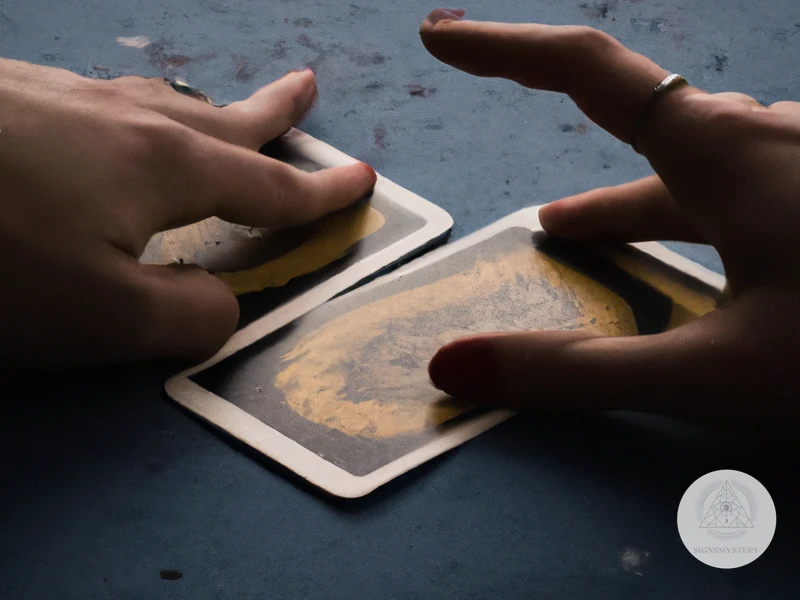
Tarot cards are a tool that can help us uncover our subconscious patterns and beliefs. The symbols on the tarot cards tap into our subconscious mind and can reveal insights that we may not be aware of consciously. There are various tarot spreads that are specifically designed to uncover these patterns and beliefs.
Tarot cards tap into the subconscious mind through the use of symbols and archetypes. The symbols on the cards are universal and are representative of common themes and experiences that we all go through. These symbols can have different meanings for different people, depending on their personal experiences and beliefs.
When we look at a tarot card, our subconscious mind begins to recognize the symbols and themes on the card. It then begins to make connections between these symbols and our own personal experiences and beliefs. This process can reveal insights and information that we may not have been aware of consciously.
There are various tarot spreads that are specifically designed to uncover subconscious patterns and beliefs. One such spread is the shadow work spread. This spread is designed to help us uncover and work through our shadow selves, which are the parts of us that we may try to hide or repress.
Another spread that can help uncover subconscious patterns and beliefs is the past-present-future spread. This spread allows us to explore how our past experiences and beliefs are affecting our present and future.
How to Use Tarot Cards for Uncovering Subconscious Patterns and Beliefs
To use tarot cards for uncovering subconscious patterns and beliefs, first choose a tarot spread that is designed for this purpose. Shuffle the cards and focus on the question or issue that you want to explore. Then, lay out the cards according to the chosen spread.
As you interpret the meaning of each card, pay attention to the symbols and themes that are present. Try to make connections between these symbols and your own personal experiences and beliefs. Allow your subconscious mind to guide your interpretation and trust your intuition.
Interpreting Tarot Card Readings
When interpreting tarot card readings, it is important to remember that there are both traditional meanings and intuitive meanings for each card. Traditional meanings are based on the common interpretations of the symbols and themes on the card. Intuitive meanings are based on your personal connection and interpretation of the symbols and themes.
It is important to trust your intuition when interpreting tarot card readings. Your intuition can guide you towards insights and information that may not be immediately obvious from the traditional meanings of the cards.
Tarot cards can be a powerful tool for uncovering subconscious patterns and beliefs. By tapping into the symbols and themes on the cards, we can gain insight into our own personal experiences and beliefs. Tarot cards can help us improve our self-awareness and personal growth, and break negative patterns and beliefs.
How Tarot Cards Tap into the Subconscious Mind
Tarot cards are a powerful tool for tapping into the subconscious mind. The imagery and symbolism on the cards speak to our intuition and emotions, which are both key elements of the subconscious mind. When we consult the tarot, we enter a meditative state where our awareness is focused inward, allowing us to access deeper parts of ourselves.
The archetypes and symbols on the tarot cards are universal, and therefore they resonate with our subconscious mind on a profound level, often revealing insights and truths that we may not be consciously aware of. The subconscious mind is the seat of our emotions, beliefs, and motivations, and the tarot cards can help us access these hidden aspects of ourselves.
As we shuffle the deck and lay out the cards, we become more attuned to our intuition and inner guidance, which provides a channel for communicating with the subconscious mind. In this state, we can ask questions and receive answers that come from a deeper place within us, providing clarity and understanding.
The act of consulting the tarot can also be therapeutic, allowing us to access and process repressed emotions and experiences. The images and symbols on the cards can bring these unconscious elements to the surface, allowing us to confront and work through them.
In addition to tapping into the subconscious mind, the tarot also has the power to connect us with the collective unconscious. This is the idea that there are universal patterns of thought and behavior that exist within all of us, and that can be accessed through tools like the tarot. By tapping into these archetypal energies, we can gain a deeper understanding of our place in the world and our purpose in life.
The tarot is a powerful tool for accessing the subconscious mind and gaining insight and clarity. It allows us to connect with our intuition, process repressed emotions, and tap into universal patterns of thought and behavior.
Types of Tarot Spreads for Uncovering Subconscious Patterns and Beliefs
Tarot spreads refer to the patterns in which tarot cards are laid out during a reading. These spreads vary in complexity and can have different numbers of cards. Here are some tarot spreads that can be used to uncover subconscious patterns and beliefs:
The Celtic Cross Spread: This spread is one of the most popular and commonly used spreads in tarot readings. It consists
Subscribe to Our Newsletter
Sign up to receive the latest news and updates.
The Three-Card Spread: This spread is a simple and quick way to gain insight into a specific issue. The three cards can represent the past, the present, and the future or the conscious, unconscious, and higher self. By understanding the underlying patterns surrounding an issue, you can discover how to move forward in a positive direction.
The Zodiac Spread: This unique spread uses the twelve astrological signs as the framework for the reading. Each card is placed in a specific position that corresponds to the sign of the zodiac it represents. The Zodiac spread is ideal for identifying patterns and beliefs that are connected to your astrological birth chart.
The Horseshoe Spread: This spread is ideal for examining a specific question or problem. The Horseshoe Spread involves seven cards, arranged in the shape of a horseshoe. The cards are interpreted in a specific order, allowing you to gain a deeper understanding of the issue and the subconscious beliefs that may be impacting it.
The Shadow Work Spread: This spread is designed to shine a light on the parts of yourself that you may have suppressed or denied. The Shadow Work Spread involves six cards, with each card representing a different aspect of yourself that you may be hiding from. By uncovering these hidden beliefs and patterns, you can work towards personal growth and healing.
Each tarot spread has its own unique benefits in uncovering subconscious patterns and beliefs. It’s important to choose a spread that aligns with your specific needs and goals.
Interpreting Tarot Card Readings
Once you have laid out the cards in a tarot spread, the next step is to interpret what they mean. Interpretation can be both challenging and rewarding, as it requires a combination of knowledge, intuition, and personal experience.
Traditional Meanings vs. Intuitive Meanings: The traditional meanings of tarot cards are a great starting point for interpretation, but they should not be relied upon solely. Intuitive meanings that resonate with the individual are just as important, as they may offer insight that the traditional meanings may not. It is important to trust personal intuition, as it can provide a unique and valuable perspective.
Common Symbols in Tarot Readings: Tarot cards contain various symbols that can provide deeper insight into the meaning of a reading. For example, the four elements (earth, air, fire, and water) are often represented in the four suits of the tarot deck. The element associated with each suit can offer additional interpretation for the cards drawn. Additionally, certain numbers and images may also have specific meanings in tarot readings and should be considered during interpretation.
Interpretation also involves taking into account the position of the cards within the spread. For example, cards in the “past” position may represent events or influences that occurred in the past, while cards in the “future” position may represent potential outcomes. The relationship between the cards, such as their proximity to each other or any patterns they form, can also provide additional insight.
Ultimately, the interpretation of tarot cards is subjective and can vary between readers and individuals. It is important to approach interpretation with an open mind and a willingness to explore the various meanings and symbols present in the reading. With practice and experience, the interpretation of tarot cards can become a valuable tool for self-discovery and personal growth.
Traditional Meanings vs. Intuitive Meanings
When interpreting tarot card readings, there are two main approaches: traditional meanings and intuitive meanings. Traditional meanings are the pre-determined meanings that are commonly associated with each card. These meanings have been passed down through tarot history and are often used as a foundation for interpreting tarot readings.
However, relying solely on traditional meanings can limit the potential depth and personalization of the reading. That’s where intuitive meanings come in. Intuitive meanings are derived from the individual’s personal interpretations of the card and what it may symbolize for them specifically.
While traditional meanings can provide a helpful starting point, it’s important to remember that every person’s interpretation of a card can differ based on their personal experiences and subconscious associations. This is why it’s essential for the reader to tap into their intuition and use it to guide their interpretation of the cards.
Some may argue that intuitive meanings are less reliable or accurate than traditional meanings, but it’s important to note that the tarot is ultimately a tool for self-discovery and personal growth. Intuitive meanings can provide a unique and personalized interpretation, allowing the reader to uncover deeper subconscious patterns and beliefs that may not have been revealed through a traditional interpretation.
Incorporating both traditional and intuitive meanings in a tarot reading can provide a well-rounded and meaningful interpretation. By considering both approaches, the reader has the opportunity to explore not only the commonly accepted meanings of a card, but also how it may relate to the individual’s personal life experiences and subconscious beliefs.
Common Symbols in Tarot Readings
Tarot readings often involve interpreting symbols on the cards to gain insight into subconscious patterns and beliefs. While some tarot decks may have unique symbols, there are several common symbols found in most tarot decks.
The Fool
The Fool card typically depicts a man walking off a cliff or edge, carrying a bag on a stick. This card can represent new beginnings, taking a leap of faith, or foolishness.
The Magician
The Magician card often portrays a figure standing behind a table with various objects on it. This card can represent the power of manifestation, creativity, and taking action.
The High Priestess
The High Priestess card often depicts a woman seated between two pillars with a crescent moon at her feet. This card can represent intuition, the subconscious mind, and secrets.
The Empress
The Empress card often portrays a pregnant woman surrounded by lush vegetation. This card can represent abundance, nurturing, and motherhood.
The Emperor
The Emperor card usually depicts a man sitting on a throne with a scepter, representing stability, structure, and authority.
The Hierophant
The Hierophant card usually shows a religious figure or authority figure. This card can represent tradition, conformity, and following established rules.
The Lovers
The Lovers card can depict a man and a woman standing beneath an angel, representing love, choice, and balance between masculine and feminine energies.
The Chariot
The Chariot card often portrays a charioteer riding a chariot, symbolizing control, willpower, and taking charge of one’s own path.
The Strength
The Strength card often shows a woman taming a lion, representing inner strength, courage, and the ability to overcome obstacles.
The Death
The Death card often depicts a skeleton or figure with a scythe, representing endings, transformation, and rebirth.
By understanding these common symbols, tarot readers can gain a deeper understanding of the subconscious patterns and beliefs that may be affecting a person’s life. However, it’s important to note that the interpretation of symbols can vary depending on the individual and the context of the reading.
Benefits of Uncovering Subconscious Patterns and Beliefs with Tarot Cards
Uncovering subconscious patterns and beliefs with tarot cards offers numerous benefits for personal growth and self-awareness. By delving deep into the subconscious, one gains a better understanding of the underlying beliefs and patterns that shape their thoughts, emotions, and behaviors. This newfound awareness provides the opportunity to address any negative or limiting beliefs and replace them with more positive ones.
One of the main benefits of using tarot cards for this purpose is improved self-awareness. The insights gained from a tarot reading can help individuals better understand themselves, their motivations, and their emotions. This knowledge can then be used to develop strategies for personal growth, enhance decision-making skills, and foster more fulfilling relationships.
Another benefit of using tarot cards to uncover subconscious patterns and beliefs is the potential for breaking negative patterns and beliefs. Often, we are not even aware of the underlying reasons behind our negative behaviors or thought patterns. By gaining insight into our subconscious beliefs and patterns through tarot, we can consciously work on transforming them and creating positive change in our lives.
Using tarot cards for personal growth and self-awareness can also bring a sense of clarity and direction. When we are struggling with a particular issue or decision, the cards can provide guidance and insight that we may not have previously considered. The symbols and archetypes found in tarot readings can help us tap into our intuition and make more informed choices.
In addition to these benefits, working with tarot cards can also offer a sense of empowerment and self-confidence. By facing our deepest fears and challenges head-on, we gain the courage to take on new challenges and pursue our goals with greater clarity and intention.
Uncovering subconscious patterns and beliefs with tarot cards can be a powerful tool for personal growth and transformation. Through self-awareness, breaking negative patterns, gaining clarity and direction, and cultivating empowerment and confidence, individuals can create a more fulfilling and purposeful life.
Improved Self-Awareness and Personal Growth
Uncovering subconscious patterns and beliefs with tarot cards can lead to improved self-awareness and personal growth. When we have a deeper understanding of our subconscious mind, we can identify the root causes of our behavior patterns and beliefs. With this knowledge, we can work towards making positive changes in our lives.
Tarot cards can serve as a powerful tool for self-reflection and self-exploration. Through the process of a tarot reading, we can tap into our inner wisdom and gain insight into our thought patterns and behaviors. This can help us recognize any negative patterns or beliefs that may be holding us back from achieving our goals.
By examining the cards and interpreting their messages, we can develop a deeper understanding of ourselves and our experiences. This can lead to greater self-awareness and a more profound sense of insight into our lives. We may discover our hidden talents, strengths, and inner resources that we may not have otherwise explored.
Tarot readings can encourage us to reflect on our current situation and re-evaluate our priorities. By gaining a more profound understanding of our subconscious mind, we can make positive changes that align with our authentic selves.
Using tarot cards to uncover subconscious patterns and beliefs can lead to significant personal growth and development. It can help us develop a deeper understanding of ourselves, build resilience, and improve our overall well-being.
Breaking Negative Patterns and Beliefs
One of the most powerful benefits of using tarot cards to uncover subconscious patterns and beliefs is the ability to break negative patterns and beliefs. Once these patterns and beliefs are brought to the surface, the individual is able to recognize them and take steps towards changing them.
The first step in breaking negative patterns and beliefs is awareness. Through tarot card readings, an individual is able to gain a deeper understanding of their subconscious mind and the patterns and beliefs that have been holding them back. This awareness is essential in making positive changes in one’s life.
Once awareness has been achieved, the second step is to challenge and question the negative patterns and beliefs. Tarot card readings may reveal patterns and beliefs that are no longer serving the individual and may be hindering their personal growth. By questioning these beliefs and examining their validity, an individual can begin to break free from them.
The final step is to replace the negative patterns and beliefs with positive ones. Tarot card readings can provide insights into areas where an individual can focus their attention and efforts to create positive change in their life. By focusing on these areas and adopting new, positive beliefs and patterns, an individual can experience personal growth and a more fulfilling life.
It is important to note that breaking negative patterns and beliefs is not always an easy process. It requires a commitment to personal growth and a willingness to confront difficult truths about oneself. However, the results can be life-changing and lead to a happier, more fulfilling life. With the help of tarot cards, individuals can gain the awareness and insight needed to break free from negative patterns and beliefs and create a better future for themselves.
Conclusion
In conclusion, using tarot cards to uncover subconscious patterns and beliefs is a powerful tool for personal growth and self-awareness. By tapping into the subconscious mind, tarot cards can reveal hidden patterns and beliefs that may be holding us back or causing us problems in our lives.
Through a variety of tarot spreads, we can explore these patterns and gain insight into their origins and effects on our lives. Interpreting tarot card readings can be both analytical and intuitive, allowing for a deep understanding of our subconscious selves.
By uncovering these patterns and beliefs, we can work towards breaking negative cycles and promoting positive change in our lives. Improved self-awareness can lead to a greater sense of purpose and fulfillment, as well as better relationships with those around us.
While tarot cards may not be for everyone, they can provide a unique perspective on our inner selves and offer guidance on our personal journeys. With an open mind and a willingness to explore, tarot cards have the potential to be a valuable tool for personal growth and understanding.
Frequently Asked Questions
What is the difference between the conscious and subconscious mind?
The conscious mind refers to our present awareness, while the subconscious mind contains information and beliefs that are not currently in our awareness.
How do subconscious patterns and beliefs affect our lives?
Subconscious patterns and beliefs can influence our thoughts, feelings, and behaviors, often without us realizing it. They can also contribute to self-sabotaging behaviors and negative patterns.
What are tarot cards?
Tarot cards are a tool used for divination and self-exploration. They typically consist of a deck of cards, each with its own symbolism and meaning.
What is the history of tarot cards?
The origins of tarot cards are debated, but the first known deck dates back to Italy in the 1400s. They were originally used for playing games before evolving into a tool for divination.
How do tarot cards work?
Tarot cards can be used to tap into the subconscious mind and access deep insights and wisdom. The reader shuffles the cards and asks a question, and then draws cards to create a symbolic narrative that can be interpreted for guidance.
What are some common symbols in tarot readings?
Common symbols in tarot card readings include the sun, the moon, the judgment card, the tower, and the fool.
What are the benefits of using tarot cards to uncover subconscious patterns and beliefs?
Tarot cards can help improve self-awareness and personal growth by uncovering hidden beliefs and patterns. They can also aid in breaking negative patterns and beliefs.
What is the difference between traditional and intuitive meanings in tarot readings?
Traditional meanings are based on established symbolism and interpretations, while intuitive meanings are based on the reader’s personal interpretation and connection to the cards.
What are some popular tarot spreads for uncovering subconscious patterns and beliefs?
Popular tarot spreads include the Celtic Cross, the Three-Card Spread, and the Shadow Work Spread.
Do I need to have psychic abilities to use tarot cards?
No, anyone can learn to use tarot cards with practice and study. It is not necessary to have any specific psychic abilities.






